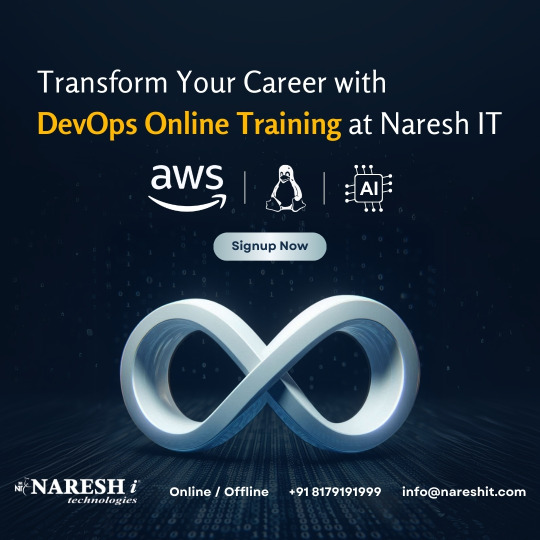#DevOps automation
Explore tagged Tumblr posts
Text
Accelerate Your DevOps Career with AWS Bootcamp Training
In today's fast-paced digital landscape, the demand for efficient and agile IT practices has never been higher. As organizations continue to adopt cloud-native applications and microservices architectures, DevOps fundamentals have become a cornerstone of successful IT operations. Among the myriad of cloud platforms, AWS (Amazon Web Services) stands out as a leader in providing robust cloud infrastructure that fuels innovation and scalability.
This comprehensive guide explores how AWS Bootcamp Training can accelerate your DevOps career. We delve into key concepts like Continuous Integration (CI), Continuous Deployment (CD) with AWS, Infrastructure as Code (IaC), and many other essential components. Whether you’re an aspiring DevOps professional or a seasoned engineer looking to upgrade your skills, this bootcamp offers the practical experience and cutting-edge knowledge needed to thrive in a cloud-centric world.

Why DevOps is Critical for Modern IT
Transforming IT Operations
DevOps is more than just a set of practices—it’s a cultural transformation that bridges the gap between development and operations teams. By adopting DevOps best practices, companies can streamline software development, reduce deployment times, and respond to market demands swiftly. DevOps empowers teams to:
Automate repetitive tasks to minimize human error.
Enhance collaboration across different departments.
Implement robust version control with Git to manage code efficiently.
Increase scalability with AWS by leveraging cloud-native solutions.
The ability to seamlessly integrate development, testing, and deployment processes is what gives businesses a competitive edge in today’s fast-paced environment.
The Power of AWS in DevOps
Leading Cloud Infrastructure
AWS offers an extensive range of cloud services that have revolutionized the way applications are built, deployed, and managed. Its comprehensive suite of tools includes computing power, storage, databases, analytics, and machine learning services—all of which are crucial for modern DevOps practices.
Key AWS DevOps Tools
Understanding the AWS ecosystem is essential for any DevOps professional. Here are some of the critical AWS tools that are often covered in a bootcamp setting:
AWS CloudFormation: Allows you to model and set up your AWS resources using templates, automating the provisioning of infrastructure as code.
AWS CodePipeline: Facilitates continuous integration and continuous deployment (CI/CD) by automating the build, test, and deploy phases.
AWS CodeDeploy: Automates code deployments to any instance, including AWS EC2 and on-premises servers.
AWS Lambda for DevOps: Enables you to run code in response to triggers without provisioning or managing servers.
AWS Elastic Beanstalk: Simplifies the deployment and management of applications by handling the underlying infrastructure.
AWS EC2 for DevOps: Offers scalable computing capacity, which is critical for running applications, containers, and microservices.
Each of these tools plays a vital role in automating processes and ensuring that the DevOps lifecycle is efficient and error-free.
Key Components of AWS Bootcamp Training
A well-structured AWS Bootcamp is designed to cover the entire DevOps lifecycle—from planning and development to deployment and monitoring. Below are some of the core areas of focus:
1. DevOps Fundamentals
Before diving into the specifics of AWS, bootcamps lay the groundwork with essential DevOps fundamentals. This includes:
An introduction to agile methodologies.
The significance of continuous integration (CI) and continuous deployment (CD).
Best practices in collaboration, version control with Git, and security in DevOps.
Understanding these core principles is critical, as they form the backbone of effective DevOps practices and set the stage for more advanced topics.
2. AWS Cloud Infrastructure
Participants gain hands-on experience with AWS cloud infrastructure. Training modules typically cover:
Setting up and managing virtual servers using AWS EC2 for DevOps.
Configuring secure, scalable storage solutions.
Networking and security configurations to protect sensitive data and applications.
This foundational knowledge ensures that you can deploy and manage applications confidently in a cloud environment.
3. Continuous Integration and Continuous Deployment (CI/CD)
Automation is a key theme in DevOps, and bootcamps place significant emphasis on CI/CD pipelines. Trainees learn how to:
Set up automated pipelines using AWS CodePipeline.
Integrate testing frameworks to ensure code quality.
Deploy applications seamlessly using AWS CodeDeploy.
By mastering CI/CD with AWS, you can dramatically reduce release cycles and improve overall software quality.
4. Infrastructure as Code (IaC)
Infrastructure as Code is revolutionizing how IT infrastructure is provisioned and managed. Bootcamp sessions on Infrastructure as Code (IaC) typically include:
Hands-on training with AWS CloudFormation to automate resource provisioning.
Best practices for versioning infrastructure configurations.
Strategies for scaling applications reliably using code-based infrastructure management.
IaC not only improves consistency and reliability but also enhances the overall security and manageability of cloud deployments.
5. Monitoring and Logging in AWS
After deployment, monitoring and logging become critical to maintain performance and identify issues quickly. Training covers:
Implementing monitoring solutions to track application performance.
Using AWS logging tools to troubleshoot and resolve issues.
Integrating monitoring solutions with automated alerts to ensure proactive maintenance.
These practices help ensure that your deployed applications remain robust and perform optimally, even under variable load conditions.
6. Containerization with Docker on AWS
Modern DevOps practices often involve containerization to ensure portability and scalability. Bootcamp training on Containerization with Docker on AWS typically covers:
Building and managing Docker containers.
Deploying containerized applications on AWS.
Leveraging AWS services like AWS Elastic Beanstalk and Amazon ECS (Elastic Container Service) for container orchestration.
Containerization simplifies application deployment and scaling, making it an invaluable skill for modern DevOps professionals.
7. Advanced AWS DevOps Tools and Best Practices
The AWS Bootcamp Training also introduces advanced topics such as:
AWS Lambda for DevOps: Using serverless computing to enhance agility.
Security in DevOps: Integrating security best practices into every stage of the DevOps lifecycle.
Scalability with AWS: Leveraging AWS to build systems that scale effortlessly in response to demand.
These advanced modules ensure that participants are not just familiar with AWS tools, but can also apply DevOps best practices to create robust, scalable, and secure systems.
Benefits of AWS Bootcamp Training
Accelerated Learning Curve
One of the primary advantages of an AWS Bootcamp is its intensive curriculum that compresses months or even years of learning into a short, focused period. This accelerated learning curve means that you can rapidly acquire the skills necessary to:
Implement Continuous Integration (CI)
Master Continuous Deployment (CD) with AWS
Apply Infrastructure as Code (IaC) principles
Hands-On Practical Experience
Bootcamp training emphasizes practical, real-world applications. You’ll work on projects that mimic industry scenarios, ensuring that you gain:
Practical experience with AWS DevOps tools.
A solid understanding of Automation in DevOps.
The ability to design, deploy, and manage cloud infrastructure effectively.
This hands-on approach ensures that you are job-ready as soon as you complete your training.
Enhanced Career Opportunities
With the rapid growth of cloud computing and the rising importance of DevOps, professionals with AWS skills are in high demand. Graduates of AWS Bootcamp Training are well-positioned to:
Drive innovation in their organizations.
Implement scalable, secure, and efficient cloud solutions.
Lead initiatives that leverage AWS cloud infrastructure for business transformation.
Whether you’re looking to advance within your current role or transition into a new career, the skills acquired through bootcamp training are highly marketable.
Networking and Mentorship
AWS Bootcamp Training also provides valuable networking opportunities. You’ll connect with like-minded professionals, experienced mentors, and industry experts who can guide your career growth. The community aspect of a bootcamp is invaluable for:
Exchanging ideas and best practices.
Staying updated with the latest trends in DevOps and cloud computing.
Receiving career support and advice from seasoned professionals.
Implementing DevOps Best Practices with AWS
To truly reap the benefits of your AWS Bootcamp training, it’s important to integrate the knowledge and skills you’ve acquired into your daily work. Here are some strategies to implement DevOps best practices:
1. Automate Everything
Automation lies at the heart of DevOps. Whether it’s code deployment or infrastructure provisioning, automate repetitive tasks using tools like AWS CodePipeline, AWS CodeDeploy, and AWS CloudFormation. Automation not only reduces human error but also accelerates your development lifecycle.
2. Embrace Continuous Integration and Deployment
By setting up robust CI/CD pipelines, you ensure that your code is constantly tested and deployed. This approach minimizes the risks associated with manual deployments and allows you to quickly roll back changes if necessary.
3. Leverage Version Control with Git
Effective version control is essential for tracking changes and collaborating with your team. Use Git to manage code repositories, merge changes, and maintain a detailed history of your projects. This practice is fundamental to successful DevOps operations.
4. Focus on Security and Compliance
Security in DevOps is critical, especially when dealing with sensitive data and complex cloud infrastructures. Implement security best practices at every stage of the development lifecycle. Utilize AWS security tools and protocols to protect your applications and data from threats.
5. Monitor, Log, and Optimize
After deployment, continuous monitoring and logging are crucial for maintaining the health and performance of your applications. Use AWS monitoring tools to gain insights into system performance, identify bottlenecks, and optimize resource utilization. Regularly review logs to troubleshoot issues and refine your processes.
6. Stay Agile and Adaptive
The world of DevOps is ever-changing. Stay agile by continuously learning, experimenting with new tools, and adapting to emerging trends. Embrace a culture of continuous improvement that allows you to refine your processes and drive innovation.
Real-World Use Cases and Success Stories
Case Study: Automating Deployment with AWS CodePipeline
Consider an organization that faced challenges with slow, error-prone manual deployments. By implementing an automated pipeline with AWS CodePipeline and AWS CodeDeploy, the company was able to reduce deployment times from hours to minutes. This transformation not only increased operational efficiency but also enhanced product quality and customer satisfaction.
Case Study: Infrastructure as Code Transformation
Another success story comes from a team that transitioned from manual server provisioning to using AWS CloudFormation for IaC. This change enabled them to manage their cloud infrastructure with greater consistency, reduce downtime during deployments, and achieve a scalable architecture that could quickly adapt to increased demand.
The Impact on Career Growth
Many professionals who have completed AWS Bootcamp Training report significant career advancements. Whether it’s stepping into a DevOps leadership role or transitioning into a specialized cloud engineering position, the skills acquired from bootcamp training open doors to new opportunities. These professionals not only implement AWS cloud infrastructure efficiently but also become ambassadors of DevOps best practices within their organizations.
The Future of DevOps and AWS
As technology continues to evolve, the synergy between DevOps and AWS will become even more pronounced. Here’s what to expect in the coming years:
Increased Automation and AI Integration
The integration of artificial intelligence and machine learning into DevOps tools is on the rise. Future AWS DevOps tools are expected to incorporate predictive analytics and intelligent automation, further streamlining the development and deployment processes.
Greater Emphasis on Containerization and Serverless Architectures
With the growing adoption of containerization with Docker and serverless computing via AWS Lambda for DevOps, the future landscape will emphasize lightweight, agile, and highly scalable application architectures.
Enhanced Security and Compliance Frameworks
As cyber threats become more sophisticated, integrating robust security measures into DevOps workflows will remain a priority. Continuous monitoring, automated compliance checks, and real-time threat detection will be essential components of future AWS solutions.
Continuous Learning and Upskilling
The rapid pace of technological change means that continuous learning is more important than ever. Participating in advanced bootcamps, workshops, and training sessions will be critical for professionals who want to stay ahead of the curve in the competitive field of DevOps.
Conclusion
AWS Bootcamp Training is an excellent investment for anyone looking to accelerate their DevOps career. By covering essential topics—from DevOps fundamentals and AWS cloud infrastructure to Continuous Integration (CI), Continuous Deployment (CD) with AWS, and Infrastructure as Code (IaC)—this training equips you with the practical skills and hands-on experience required to thrive in a competitive market.
You’ll learn how to effectively use a suite of powerful AWS DevOps tools such as AWS CloudFormation, AWS CodePipeline, AWS CodeDeploy, and more. In addition, you’ll master key practices in automation, containerization with Docker, and monitoring and logging in AWS, all while staying true to DevOps best practices.
As cloud computing continues to evolve, the integration of advanced technologies like serverless computing and container orchestration will further enhance the potential of AWS. By staying agile, embracing continuous improvement, and leveraging the latest AWS technologies, you can build scalable, secure, and resilient systems that drive business success.
Take the Next Step in Your DevOps Journey with Kodestree
If you’re ready to transform your career and gain hands-on expertise in AWS and DevOps, consider enrolling in an AWS Bootcamp Training program. At Kodestree, we offer comprehensive, industry-focused courses that empower you to master essential AWS tools and DevOps practices. Whether you’re new to the field or looking to upskill, our training programs provide the practical knowledge and real-world experience needed to accelerate your career.
Enroll today at Kodestree and take the first step towards becoming a leader in DevOps. Embrace the future of cloud computing and automation—your journey to success starts now!
0 notes
Text
0 notes
Text
Role of AI and ML in Cloud Computing

AI and ML significantly enhance cloud computing by automating processes, improving efficiency, and optimizing resource management. They enable auto-scaling, load balancing, and predictive analytics, allowing businesses to anticipate system failures and customer needs. AI-driven security measures detect threats in real-time, while personalized services enhance user experiences through recommendations and content delivery. Additionally, AI/ML tools in cloud platforms (AWS, Google Cloud, Azure) make these technologies more accessible. Their role in edge computing and DevOps automation further boosts performance and scalability.
For more information you can refer this blog: https://makelinkit.com/blogs/impact-of-ai-ml-on-cloud-computing
0 notes
Text
Cloud Cost Optimization: How DevOps Automation Can Reduce Your AWS/Azure Bills
Managing cloud costs can be challenging, but with the right DevOps automation strategies, you can significantly reduce your AWS and Azure bills. In this webinar, Aloud Launch Pad will show you how to leverage automation to optimize cloud spending, improve resource efficiency, and maximize ROI
Register now to start saving on your cloud costs! 🚀
1 note
·
View note
Text
CI/CD Pipeline Integration: Streamline Software Delivery with Assure QA
In today’s fast-paced development world, CI/CD Pipeline Integration is essential for seamless, automated software delivery. By integrating continuous testing and deployment, businesses can accelerate releases while maintaining quality.
Assure QA is the ultimate online platform for software quality assurance, offering functional, automation, performance, and security testing. With cutting-edge tools, Assure QA ensures robust, high-performing software, tailored to your needs. Whether it's web, API, or cross-browser testing, Assure QA empowers teams with reliable, scalable solutions.
Optimize your CI/CD workflow with Assure QA—where innovation meets reliability!


#CI/CD Pipeline Integration#DevOps Automation#Automated Testing Tools#API and Web Testing#Software Quality Assurance#Cross-Browser Compatibility Testing
1 note
·
View note
Text

Benefits Of DevOps Automation Tools For Seamless CX Upgrades
Customer experience (CX) is a rapidly evolving industry, with 80% of companies identifying DevOps as a key factor in scaling service quality. Integrating DevOps automation into CX operations brings substantial benefits, allowing teams to keep pace with customer demands, launch new features quickly, and resolve issues before they affect service. By minimizing manual intervention, DevOps automation tools improve productivity and enable CX teams to focus on creating seamless experiences across every customer interaction.
CX is inherently fast-paced and complex. Platforms require ongoing updates, precise configuration, and high scalability to meet dynamic customer needs. With automation, companies can unify operations, reduce deployment errors, and increase service uptime, setting the stage for a consistently high-quality customer journey. Below, we dive into the specific benefits DevOps automation can offer CX teams.
Why choose Blackchair Symphony for DevOps automation in CX?
At Blackchair, we know that successful DevOps automation in CX requires more than just implementing a standard set of tools. Each CX environment has specific demands, from CCaaS configuration to the need for rapid scalability and flawless performance. Our experts bring deep experience in selecting and integrating the ideal automation tools that fit your unique CX requirements, empowering your team to achieve reliable deployments, seamless scaling, and robust service reliability.
With comprehensive support across strategy, execution, and ongoing optimization, we handle the intricacies of automation so your team can prioritize delivering memorable, high-quality customer experiences at every touchpoint.
#DevOps Automation#CX Upgrades#CX migration#CCaaS environments#CX Automation#CX solutions#CCaaS platforms
0 notes
Text

Boost Efficiency with Cloud Configuration Management
Managing a contact center today isn’t what it used to be. It’s fast-paced, high-stakes, and essential to a brand’s reputation. But as customer expectations grow, so does the complexity of running an effective contact center. Agents are juggling multiple channels, managers are handling an ever-changing array of systems, and downtime is not an option.
That’s where cloud configuration management for CCaaS comes in. Imagine being able to centralize all those moving parts, automate the repetitive stuff, and focus more on what actually matters—connecting with customers. Automated CCaaS configuration tools help you do exactly that by turning a patchwork of processes into a seamless, flexible system. With the right configuration setup, you can cut down on manual work, keep everything running smoothly, and make sure your contact center is ready to adapt as your business grows.
Why Choose Blackchair for automated cloud configuration management for CCaaS?
At Blackchair, we understand that every contact center is unique, with its own set of challenges and opportunities. Our CCaaS configuration solutions are designed to simplify your daily operations while enhancing overall performance and security. With our technology, your team gains the power to handle more volume, resolve issues faster, and deliver a level of service that keeps customers coming back.
From set-up to ongoing support, we’re here to help you create a contact center that runs like a well-oiled machine, no matter how complex or high-pressure the environment is.
#cloud configuration#CCaaS configuration#cloud configuration management#DevOps Automation#CCaaS environments#CX migration
0 notes
Text

Cloud Migration Experts For Seamless Digital Transformation
Discover how by transforming cloud transitions into growth opportunities, migration experts handle the complexity so you can focus on delivering exceptional customer experiences.
Cloud migration is no longer just an IT upgrade; it’s a strategic pivot that can redefine how businesses engage, grow, and succeed. Cloud migration experts specialize in making this transformation smooth, secure, and geared for lasting impact. From empowering flexibility in operations to unlocking new levels of scalability, the benefits are substantial—if done right.
For many organizations, the right approach to cloud migration goes beyond moving workloads; it requires strategic planning, foresight, and technical expertise. With years of experience in cloud-based transitions for diverse industries, migration experts guide businesses through every stage, ensuring not just a smooth migration but an enhanced foundation for customer engagement and innovation.
Why Blackchair’s cloud migration experts?
At Blackchair, we understand that cloud migration isn’t a “one-size-fits-all” solution. Every business has unique operational needs, customer expectations, and market pressures.
0 notes
Text

Benefits Of DevOps Automation Tools For Seamless CX Upgrades
Customer experience (CX) is a rapidly evolving industry, with 80% of companies identifying DevOps as a key factor in scaling service quality. Integrating DevOps automation into CX operations brings substantial benefits, allowing teams to keep pace with customer demands, launch new features quickly, and resolve issues before they affect service. By minimizing manual intervention, DevOps automation tools improve productivity and enable CX teams to focus on creating seamless experiences across every customer interaction.
CX is inherently fast-paced and complex. Platforms require ongoing updates, precise configuration, and high scalability to meet dynamic customer needs. With automation, companies can unify operations, reduce deployment errors, and increase service uptime, setting the stage for a consistently high-quality customer journey. Below, we dive into the specific benefits DevOps automation can offer CX teams.
Why choose Blackchair Symphony for DevOps automation in CX?
At Blackchair, we know that successful DevOps automation in CX requires more than just implementing a standard set of tools. Each CX environment has specific demands, from CCaaS configuration to the need for rapid scalability and flawless performance. Our experts bring deep experience in selecting and integrating the ideal automation tools that fit your unique CX requirements, empowering your team to achieve reliable deployments, seamless scaling, and robust service reliability.
With comprehensive support across strategy, execution, and ongoing optimization, we handle the intricacies of automation so your team can prioritize delivering memorable, high-quality customer experiences at every touchpoint.
0 notes
Text

Exploring the benefits and strategies for customer channel migration
Customer channel migration is the process of transitioning interactions from one communication channel to another, ensuring smoother customer journeys. This process allows businesses to better align with customer preferences and optimize CX across various touchpoints.
With 70% of customers expecting any agent they interact with to have the full context of their past interactions, omnichannel communications are now essential. By migrating to CCaaS, businesses can easily implement an omnichannel approach, providing seamless transitions between channels, such as from email to phone, while maintaining full visibility of the customer journey. This results in improved customer satisfaction and more efficient operations.
Seamlessly transitioning between channels isn’t just about saving time; it’s about delivering a consistent, quality experience. As businesses move into a CCaaS environment, optimizing channel ligration is key to success.
Accelerate your CCaaS migration with Clarity and elevate customer satisfaction
Clarity by Blackchair significantly improves the CCaaS migration process by automating critical steps and reducing the manual discovery burden. It accelerates CX migration by 25%, and shortens the discovery phase by 50%, allowing businesses to transition to CCaaS environments faster and more efficiently.
This faster transition means you will be able to automate channel migration processes within the CCaaS operating environment, ensuring that customer interactions are consistently handled across all channels—ultimately leading to improved customer satisfaction and operational efficiency.
0 notes
Text

Unlocking cloud migration benefits for customer-centric enterprises
For businesses at the forefront of digital transformation, the shift to the cloud is not just an IT upgrade—it’s a critical strategic move. The migration to cloud-based infrastructure enables businesses to re-architect their customer engagement strategies with increased agility, robust scalability, and an unprecedented capacity for innovation.
The real question isn’t why you should migrate to the cloud—it’s why not. Companies entrenched in legacy systems face more than operational inefficiencies; they risk falling behind the curve in delivering dynamic customer experiences. And for customer-centric enterprises, cloud migration benefits offer the competitive edge necessary to thrive in today’s hyper-connected marketplace.
Experience cloud migration benefits with Blackchair Clarity
If your business is ready to capitalize on the power of the cloud, it’s crucial to start with a well-thought-out migration strategy, tailored to customer experience transformation. Moving your contact center to the cloud requires a deep understanding of both your infrastructure and your customer engagement roadmap.
At Blackchair, we specialize in guiding enterprises through seamless CCaaS migration, ensuring that you transition to the cloud efficiently and unlock the full value of cloud-native customer experience platforms.
0 notes
Text

The future Of CX with cloud-native data platforms
In today’s digital age, CX is more important than ever with customers expecting fast, reliable, and personalized services. This means that businesses need to stay on their toes and address these changes in the CX landscape proactively if they want to remain competitive.
Businesses understand this fact too—and it is clear with the shift towards cloud-native data platforms. In fact, the cloud-native software market was valued at approximately US$ 5.8 billion in 2023 and is projected to grow to US$ 46.88 billion by 2030. It is revolutionizing how companies manage CX by offering scalability, flexibility, and integration capabilities that were previously unheard of.
This article will provide insights into how these platforms can transform customer interactions and what the future holds for businesses that embrace this technology. Let’s dive in.
The rise of cloud-native data platforms
Cloud-native platforms are built from the ground up to accentuate the best parts of cloud infrastructure—unmatched scalability, resiliency, and agility.
In addition, cloud-native platforms can make use of microservices, containers, and dynamic orchestration to swiftly adapt to customer demands and market trends.
Cloud-native platforms can offer continuous integration and delivery (CI/CD), which is crucial for faster deployments, easier rollbacks, reduced costs, and better visibility across development—so you can ensure customer-facing applications remain cutting-edge.
Elevate your CX strategy with cloud-native integration
The integration of cloud-native data platforms is really raising the bar for CX. They give businesses the power to offer quick, tailored, and top-notch services. Looking forward, businesses that jump on board with these platforms are set to take the lead in keeping customers happy and dominating the market. So, why not seize the opportunity with cloud-native data platforms to shake up your CX strategy? Opting for CCaaS migration might just be the spark for a fresh wave of customer interaction and business creativity.
0 notes
Text

What should you consider when making the decision?
As the CX landscape evolves, contact centers face a critical decision; stick with on-prem solutions or migrate to the cloud? This choice isn’t just a matter of following trends, it’s about aligning technology with business goals and customer needs.
The shift towards cloud-based contact centers has gained momentum, yet on-premises solutions persist. A 2023 Metrigy study revealed that only 29.5% of global organizations have switched to Contact Center as a Service (CCaaS).
However, 48% of these businesses – that’s almost half! – are considering changing CCaaS platform providers, with 14% even contemplating a return to on-premises platforms. This shows that the decision to move away from on-prem operations is not that straightforward of a decision—and making the the right choice for your organization is extremely important.
What’s driving the move towards cloud contact centers?
For many businesses, cloud solutions offer lower capital expenditure, improved security, and access to cutting-edge technologies. These benefits are particularly attractive now, where customer expectations are constantly evolving, and businesses need to adapt quickly.
Cloud-based contact centers also facilitate seamless integration with broader CX processes. For example, many organizations are moving their CRM systems to the cloud. Having a cloud-based contact center allows for easier integration, enabling a more holistic view of the customer journey and more personalized interactions.
From a vendor perspective, prioritizing cloud solutions makes sense. It’s more cost-effective to maintain and update a single platform rather than supporting both cloud and on-premises versions. This consolidation allows vendors to focus their resources on innovation and improvement, potentially leading to better products and services for their customers.
Should your CX be on-prem?
While the cloud offers numerous advantages, there are valid reasons why some organizations choose to maintain on-prem solutions. Regulatory requirements in certain industries and jurisdictions may require keeping data and systems on-site. For example, financial services or healthcare organizations often face strict data privacy and security regulations that can be easier to manage with on-premises solutions.
Data sovereignty and governance are also important concerns, particularly for multinational corporations or those operating in regions with strict data localization laws. On-premises solutions provide greater control over where data is stored and how it’s managed, which can be crucial for compliance.
Some organizations prefer the level of control and customization that on-premises solutions offer. They may have unique integrations or workflows that are hard to replicate in a cloud environment. Plus, for businesses with massive investments in existing infrastructure, the cost considerations of “sweating the assets” can make staying on-premises more attractive in the short term.
0 notes
Text

Boost your career with hands-on DevOps Online Training. Learn from industry experts and gain practical skills to become a DevOps pro. Enroll in our DevOps Online Training to get certified and accelerate your career!
#devops#DevOpsOnlineTraining#LearnDevOps#devops certification#DevOps Courses#DevOps Career#online training#devops engineer#devops tools#devops automation#DevOps Cloud#DevOps Best Practices#DevOps Hands-on Training#DevOps for Beginners
0 notes
Text
GitLab Environments: Your Cloud Playground Blueprint
Remember when you were a kid and tried to build the ultimate LEGO castle? You had all these cool pieces, but figuring out how they fit together was the real challenge. Well, welcome to the grown-up version: building your serverless cloud playground! Let’s take a bird’s-eye view of our LEGO set… err, I mean, our solution components. The Grand Blueprint: Components Overview Imagine you’re an…
#aws#CI/CD Pipeline#Cloud Architecture#DevOps Automation#GitLab Environments#GitLab Runner#Infrastructure as Code#OIDC Integration#Parallel Environments#Secure Cloud Access#Serverless Development#Terraform State Management
0 notes